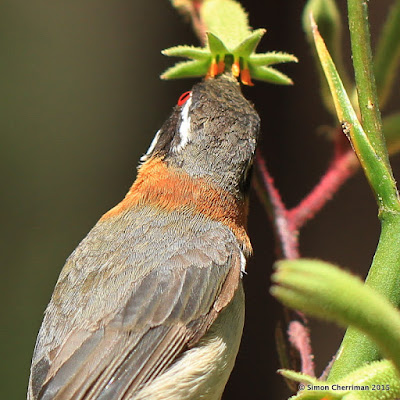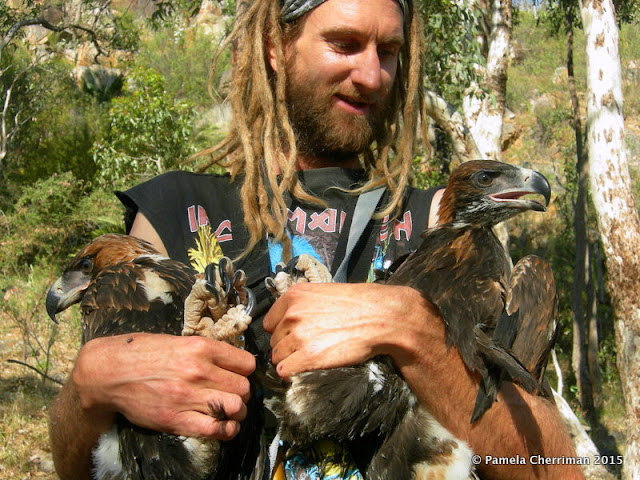Western Australia is home to a huge variety of amazing wildlife. In our unique south-west region, we are lucky enough to have 14 species of birds that are endemic - that is, they are found nowhere else on the planet. Recently, one of these species, perhaps one of the most beautiful of all Australian birds, has been visiting my garden regularly, and I've had the pleasure of being able to photograph it at close quarters.
 |
| The female Booldjit has a stunning rufous collar and red iris. |
'Booldjit' (Noongar for what most people know as the Western Spinebill, Acanthorhynchus superciliosus), is truly a gem of a bird. Both sexes have a stunning buff-coloured belly, a rufous collar and a striking red eye. And the male's black mask, white eyebrow (hence the species name superciliosus - 'supercilium' refers to a line above the eye), black cheek and black-and-white bib make him an especially eye-catching decoration in any garden. Their colour difference is the result of a phenomenon called 'sexual selection', where evolutionary pressures have caused males to develop striking feather patterns that attract females, and allow the brightest individuals the right to pass on their genes. By contrast, duller individuals are less attractive and as a consequence do not get the right to contribute to the next generation, so over time the sexes become more and more different. Sexual colour dimorphism, the result of sexual selection, is a common feature of many Australian songbirds, especially those in the wren and honeyeater families, the latter being the group to which spinebills belong.
On the topic of evolution, another feature of this brilliant bird is its aptly named bill, which has the very fine, curved shape of a spine on a plant. This bill is itself the result of millions of years of constant competition between bird and plant - the bird has evolved a longer, finer beak, the same shape as those belonging to kangaroo paws, grevilleas and other local native flora on which it feeds. Here are two successive photos of a male Booldjit probing his delicate beak into the flowers of a Tall Kangaroo Paw (Anigozanthos flavidus):
While drinking his fill of nectar, the spinebill is also performing an important pollination task, which is the benefit the 'roo paw is seeking for offering a sugar-rich reward. Carefully positioned anthers, which bear the plant's pollen, probe from the front of the flower and with every feed, give the spinebill a fine dusting of pollen on its forehead. These images showing the yellow pollen grains, like a tiny dusting of talcum powder, being passed to the spinebill's forehead, with some falling along the length of its bill as it withdraws from the first flower.
Once sugar-tube is empty, the Booldjit then flutters rapidly to the next flower, and to the next, carrying out more probing and pollinating, as it clutches the stems delicately with intricate feet. What is fascinating about observing this activity is the rapidity with which the bird forages. In less than 90 seconds it can have visited all of the 20+ flower heads on the two kangaroo paw clumps outside my kitchen window, and with several individual flower tubes on each arrangement, that's less than 2 seconds per forage!
 |
| Probing for nectar: A few pollen grans can be seen floating away to the top left of the bird's head as it forages. |
I've noticed the male spinebill is in to feed at least 3-4 times each day, whereas the female only comes about twice - once in the morning, and once in the evening. Perhaps this is because the male expends more energy defending its territory and protecting its female(s)? She is noticeably less active than him, and has often perched in a nearby shrub, resting and looking around. The more abundant Brown Honeyeaters are also more dominant, and I've seen them chase off their smaller rivals on several occasions when the two species arrive to feed simultaneously. This might explain why the spinebills are so rapid - drink your fill before someone else does!
It is a thrill to observe the intricacies of the natural world, which are constantly going on around us, on every level whether big or small.





























